 Every twenty years or so, a revolutionary new design comes along in taxidermy mannikins which alters the way all future mounts are constructed. With the latest offering of bird mannikins from legendary bird expert Shane Smith of Alabama, we may be witnessing this revolution in the way the taxidermists will mount birds for the next century. Shane’s mannikins allow much greater freedom of posing after the bird is put together, solve common anatomy problems, and save the taxidermist time. The techniques for assembly are slightly different from traditional bird taxidermy methods, so Shane has prepared two instructional video tutorials which are presented here for the first time.
Every twenty years or so, a revolutionary new design comes along in taxidermy mannikins which alters the way all future mounts are constructed. With the latest offering of bird mannikins from legendary bird expert Shane Smith of Alabama, we may be witnessing this revolution in the way the taxidermists will mount birds for the next century. Shane’s mannikins allow much greater freedom of posing after the bird is put together, solve common anatomy problems, and save the taxidermist time. The techniques for assembly are slightly different from traditional bird taxidermy methods, so Shane has prepared two instructional video tutorials which are presented here for the first time.
Shane Smith is a World Champion taxidermist and has won high acclaim for his mastery of dramatic poses in mounts. His exceptional bird anatomical knowledge and experience have positioned him well to create a new design of bird body which allows for the full range of movement with the wings, legs and neck. Shane and his employees have been using this system for several years in their high-volume studio, where they have found that these new mannikins provide a much better quality finished product while shaving as much as 20 to 30 minutes off their production time.

So what is so different about these mannikins? There are five main areas of innovation.
 The Legs
The Legs
Shane wanted to create a method where the legs could be fully rotated after mounting to front, back, tucked, or spread wide. Current mannikin attachment points did not provide for hardly any range of motion and the rotation point was always in the wrong place, creating incorrect anatomy on some leg positions. Shane’s mannikins feature a hip rotation point instead of the common knee rotation point, allowing for full range of motion, extension, tuck or spread, depending upon the pose desired. With the hip locked into place, the legs can be freely manipulated in all directions while maintaining complete anatomical accuracy for skeletal and skin placement.
 The Wings
The Wings
The wings are wired into a shoulder lock point which allows complete movement in all directions. For flying birds, this means you can manipulate the wings into the most extreme positions you desire, while still keeping all the feathers and points in the right place, with the scapulars laying flat. The flight web tendon is also anchored to the mannikin which makes the feathers behave properly no matter how radical the wing is opened, closed, or cupped. For the standing mannikins, a different wing locking system allows for perfect wings every time and as they easily tuck into the side pockets with precision.
 The Neck
The Neck
The neck cavity on these mannikins is much deeper than anything ever offered before, which lets the taxidermist explore the full range of movement of waterfowl necks, from the lowest landing pose to highest flushing take-off. New molding technology lets the neck slot to be manufactured as it should be, rather than a shallow slot for ease of de-molding. Once your bird is assembled, taxidermists can enjoy the art of posing their bird in any unique position they can imagine.
The Body Shape
On the flying bird bodies, Shane has added width to the shoulders and reduced the depth of the chest. This creates a much more realistic shape for flying birds with their wings outstretched. On the standing mannikins, narrower shoulders and a fuller chest gives the accurate full-bellied look for walking and preening poses. The side pockets on the mannikin have also been deepened to create a perfect wing fit and help all the feather groups align correctly with a minimum of taxiing.
The Tail
All of Shane’s bird bodies also include a newly designed tail area with a clearly indicated tail slot. This slot can be cut out with a knife in seconds and the cleaned tail quills will set into the slot with caulk for a prefect tail feather alignment every time.
Introductory Video
It is much easier to see the benefits of these mannikins in action than from a still photograph or description. In the following short video, Shane introduces his bird body line and explains some of the features and benefits.

Flying Bird Tutorial
Using Shane Smith’s flying bird bodies requires a somewhat different technique on trimming bones and wiring in order to take full advantage of the beneficial features of this system. The following comprehensive video tutorial provides all of the instruction you need to produce beautiful, dramatic flying waterfowl mounts.

Standing Bird Tutorial
Shane’s standing birds are designed completely different from the flying versions, and require different bone cuts and different wiring. The following video shows everything you need to know to achieve excellent results with this new system.

Shane had this to say about his new mannikin line: “After wrapping bodies and altering manikins for years and knowing the importance of proper anatomy, grooming and craftsmanship in a quality mount, I came to know some of the pitfalls we all encounter. It is difficult for most to ‘interpret’ what is going on underneath a bird’s plumage. As an instructor I found it can be difficult for all but the very best to make a bird look good. This is why I am now offering a new line of bird forms. The system I use includes all the basics but adds the rarely used ‘Emotion and Attitude’ of the bird.”
“Many of the sizes available in this new series work for other species. It is OK to mount a redhead on a form that will also fit a Greater Scaup or Surf Scoter. It is important to use what ‘works’ for that particular bird. The skin must work for the bird no matter the length or width of the carcass-body mass and fat content is different in all birds. It is most important to have the skin work on the manikin. My forms are proven for efficiency, speed, and accuracy resulting in consistent results across the board.”

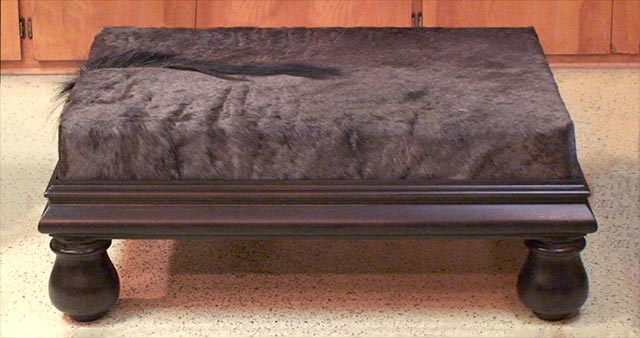
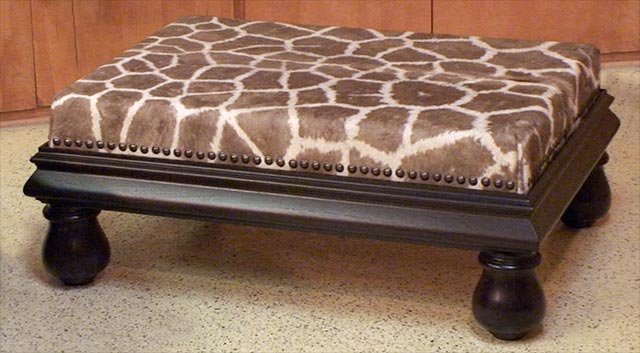
 I was recently talking to a taxidermist friend of mine when I casually asked how he liked the new McKenzie Whitetail Savings Club. His answer surprised me. He told me that had not enrolled in the club yet, even though he was buying whitetail mannikins from McKenzie every month. He said he wasn’t even planning to join. He explained, “That’s only like a dollar off on each form. It’s hardly worth my time.”
I was recently talking to a taxidermist friend of mine when I casually asked how he liked the new McKenzie Whitetail Savings Club. His answer surprised me. He told me that had not enrolled in the club yet, even though he was buying whitetail mannikins from McKenzie every month. He said he wasn’t even planning to join. He explained, “That’s only like a dollar off on each form. It’s hardly worth my time.” 

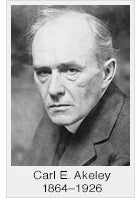 On May 21, 2014, the town of Clarendon, New York celebrated the 150th birthday of its most famous resident, Carl Akeley. Over 150 people attended the event hosted by Melissa Ierlan from the Clarendon Historical Society. Known as “the father of modern taxidermy,” Carl E. Akeley is the most revered master of his art. Nearly all modern taxidermy methods can be traced back to his innovations and inventions from a century ago.
On May 21, 2014, the town of Clarendon, New York celebrated the 150th birthday of its most famous resident, Carl Akeley. Over 150 people attended the event hosted by Melissa Ierlan from the Clarendon Historical Society. Known as “the father of modern taxidermy,” Carl E. Akeley is the most revered master of his art. Nearly all modern taxidermy methods can be traced back to his innovations and inventions from a century ago.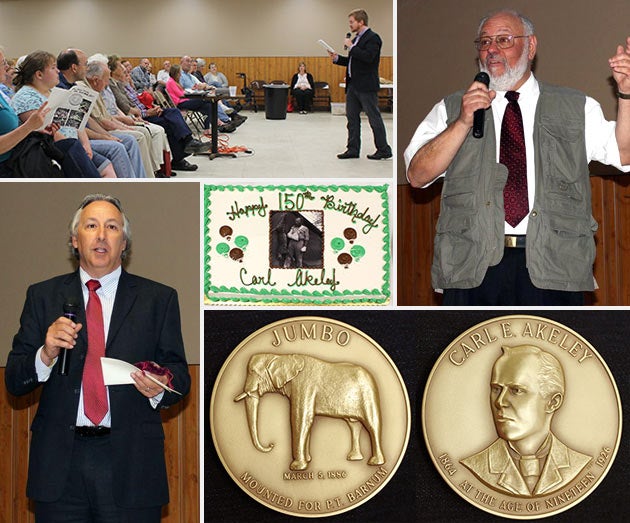
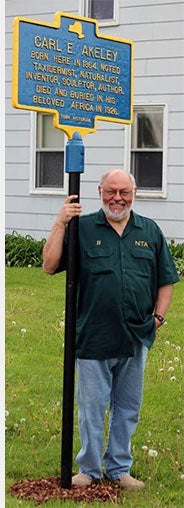 During Akeley’s fifth expedition to the African continent, he developed a fever and died on November 18, 1926 in the Belgian Congo. He was buried atop Mount Mikeno in his beloved Africa. Surprisingly, other than a historic marker indicating his birthplace in Clarendon, there is no monument or memorial to this important industry patriarch. John Janelli had been thinking about this for years, even inviting me to accompany him to the grave in Africa for the 75th anniversary of Akeley’s death back in 2001. This lack of a physical place where one could honor and pay respects to this pioneer of our industry simmered for years in the back of John’s consciousness.
During Akeley’s fifth expedition to the African continent, he developed a fever and died on November 18, 1926 in the Belgian Congo. He was buried atop Mount Mikeno in his beloved Africa. Surprisingly, other than a historic marker indicating his birthplace in Clarendon, there is no monument or memorial to this important industry patriarch. John Janelli had been thinking about this for years, even inviting me to accompany him to the grave in Africa for the 75th anniversary of Akeley’s death back in 2001. This lack of a physical place where one could honor and pay respects to this pioneer of our industry simmered for years in the back of John’s consciousness. 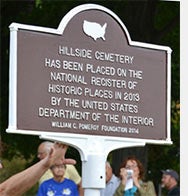 When John met Melissa Ierlan of the Clarendon Historical Society last year, they made an immediate connection. In Melissa, John discovered a kindred spirit who also wanted to see Akeley’s memory preserved for all time. By a fortunate stroke of luck, the beautiful Hillside Cemetery in Clarendon was named to National Register of Historic Places in 2013, and Melissa Ierlan, the Clarendon town historian and president of the Historical Society, located the perfect spot within the cemetery for the monument on a tear-shaped grassy island at the end of a gravel road. Here, in Akeley’s hometown, would be the permanent memorial that John had envisioned for so many years.
When John met Melissa Ierlan of the Clarendon Historical Society last year, they made an immediate connection. In Melissa, John discovered a kindred spirit who also wanted to see Akeley’s memory preserved for all time. By a fortunate stroke of luck, the beautiful Hillside Cemetery in Clarendon was named to National Register of Historic Places in 2013, and Melissa Ierlan, the Clarendon town historian and president of the Historical Society, located the perfect spot within the cemetery for the monument on a tear-shaped grassy island at the end of a gravel road. Here, in Akeley’s hometown, would be the permanent memorial that John had envisioned for so many years.
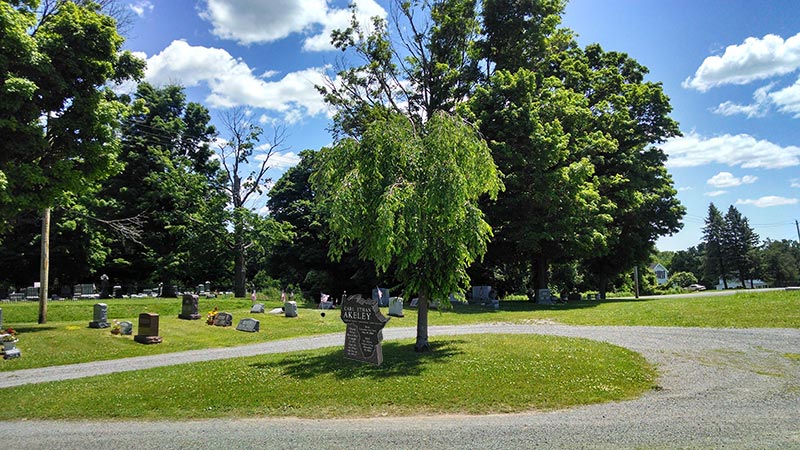
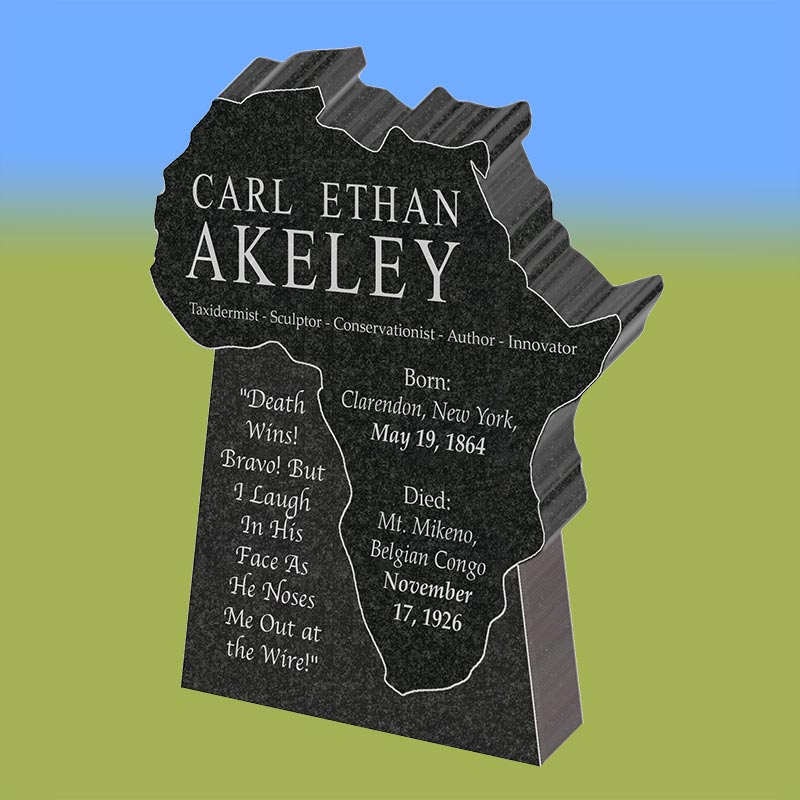
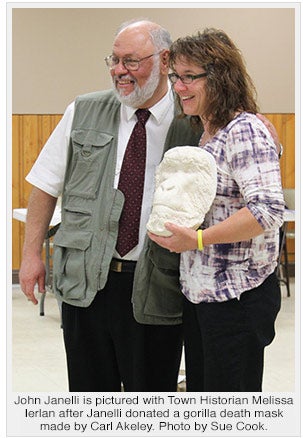 The Historical Society of Clarendon, NY – the birth place and home of Carl Ethan Akeley, is proud to announce its plans to have an official memorial stone erected in our town cemetery in honor of Mr. Akeley; taxidermist, innovator, sculptor, author and conservationist. The stone itself, black African granite, is currently being hewn from one of only a few quarries in all of Africa. When finished it will bear the shape of the African continent of which Akeley devoted so much of his life to preserve, protect and portray through taxidermy. The projected cost of this memorial is $8,000.00 not including installation expenses.
The Historical Society of Clarendon, NY – the birth place and home of Carl Ethan Akeley, is proud to announce its plans to have an official memorial stone erected in our town cemetery in honor of Mr. Akeley; taxidermist, innovator, sculptor, author and conservationist. The stone itself, black African granite, is currently being hewn from one of only a few quarries in all of Africa. When finished it will bear the shape of the African continent of which Akeley devoted so much of his life to preserve, protect and portray through taxidermy. The projected cost of this memorial is $8,000.00 not including installation expenses.